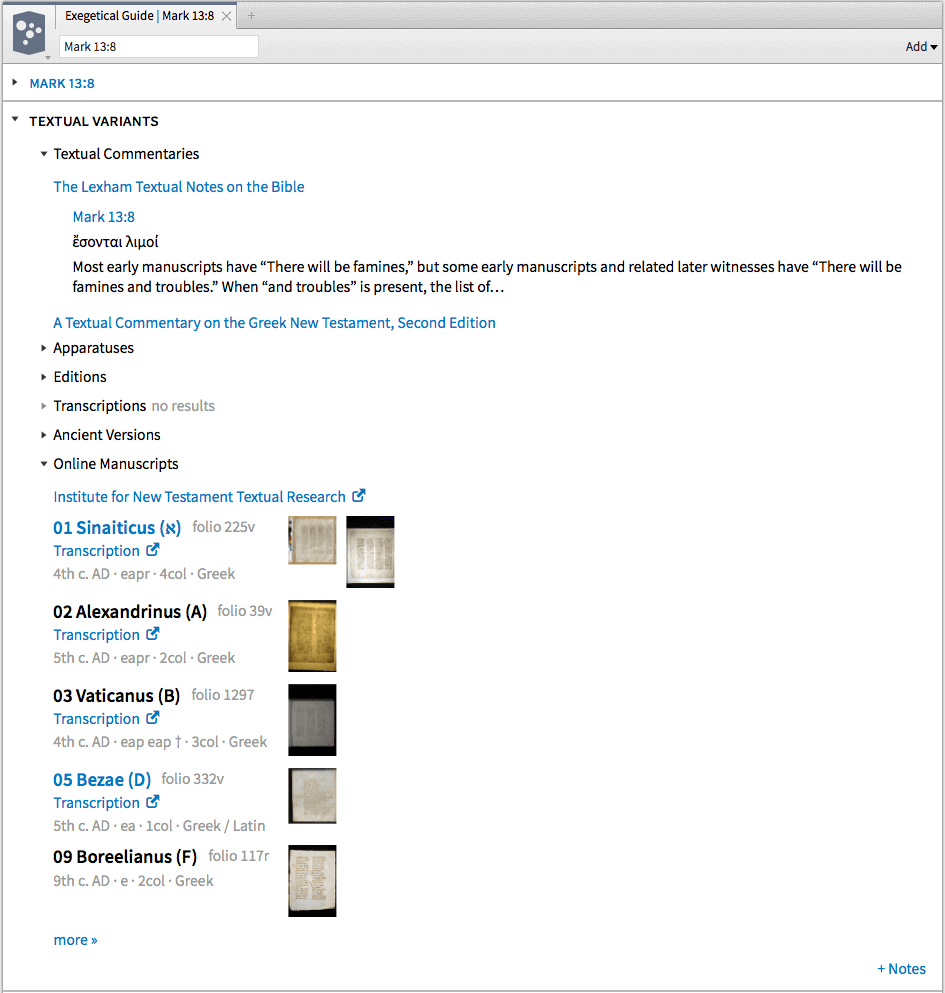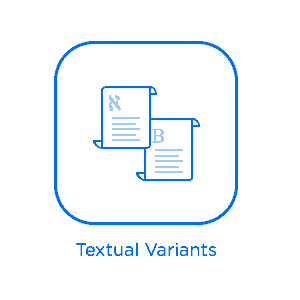Most guides to exegesis include an important step in pursuing the exegesis of a given passage: establishing the text. This is the exegetical step where textual variation is taken into account, and one notes and weighs the variations in a passage to determine the text that will be exegeted.
In previous versions of Logos, the Exegetical Guide included a section called “Apparatuses,” which was the primary source of information to be used in establishing the text for exegesis.
In Logos 6, the Exegetical Guide’s Textual Variants section is a complete redesign of what used to be the Apparatuses section. The goal of the redesign is to make it easy to get to information in your library that may help with evaluating textual variation.
There are six parts to the Textual Variants section, each representing different types or classes of resources or data relevant to examining textual variation:
- Textual commentaries
- Apparatuses
- Editions
- Transcriptions
- Ancient versions
- Online manuscripts
Textual commentaries
These are specialized commentary resources that comment on units of textual variation instead of commenting with exegetical information. The most commonly known example of this type of resource is Bruce Metzger’s A Textual Commentary on the Greek New Testament.
Most textual commentaries have been focused on the variations found in the New Testament. For Logos 6, we’ve created a new textual commentary, targeted at the lay user with little Hebrew or Greek knowledge. It covers over 2,000 variation units throughout the Hebrew Bible and the Greek New Testament.
The textual-commentaries section extracts the first portion of the note for the verse under study. This helps you get an idea what the variation is about, and it might help determine if you need to research the variation in more depth.
Other textual commentaries (such as Metzger’s) are listed in the Textual Variants section; if you click the title in your software, it will open the resource to the appropriate entry.
Apparatuses
Apparatuses are those things at the bottom of the page of some editions of the Hebrew Bible and of the Greek New Testament. They are typically laden with abbreviations, cryptic to read, and difficult to understand. They are highly compressed forms of variation data. This section largely reproduces what Logos 4 and 5’s Apparatuses section did: provide appropriate links to apparatuses so that the textual evidence for a given variation can be further evaluated.
Editions
For the purposes of the Textual Variants section, an “edition” is a version of an original-language text produced in the modern era. The use of “modern era” is wide, so these are essentially editions (not transcriptions) produced after 1500.
This section lists editions of the Hebrew Bible and the Greek New Testament—such as the Lexham Hebrew Bible (LHB), the Biblica Hebraica Westmonasteriensis (BHW), the SBL Greek New Testament (SBLGNT), the Nestle-Aland 28th edition, and the like. Editions of the Septuagint are also included for references covered by that corpus.
Transcriptions
Different than an edition, a transcription is an attempt to transcribe the text as it occurs in a particular manuscript. These also often include the pagination and line breaks of the manuscripts in question. Items included in this section would be the Qumran Biblical Dead Sea Scrolls, The Text of the Earliest New Testament Greek Manuscripts, Codex Sinaiticus, Codex Bezae Cantabrigiensis, and others.
Ancient versions
We read our Bibles in our own language, as they have been translated by experts for those who do not know the original languages. This is not new; translations of the Bible have been made from ancient times. What we call the Septuagint is a translation of the Hebrew Bible into Greek. There are other of these ancient or “early” versions, including versions in Aramaic (the Targums) and Latin (the Vulgate) as well as Coptic, Syriac, and all sorts of other languages. If you have access to any of these in your library of Logos resources, they will appear here for you to consult.
Online manuscripts
At present, this feature only works for New Testament references. It relies on information provided by the Institute for New Testament Textual Research (Institut für Neutestamentliche Textforschung, or INTF) which is the organization behind the critical editions of the Greek New Testament: the Editio Critica Maior, the Nestle-Aland family of texts, and the United Bible Societies editions of the Greek New Testament.
The information behind online manuscripts is provided through a web service operated by the INTF, known as the New Testament Virtual Manuscript Room (NTVMR). This web service offers a public interface to much of the data that is used by the textual critics at the INTF in their work preparing editions of the Greek New Testament. In other words, where available, these are the transcriptions and the manuscript images being used to inform textual critics as they prepare critical editions of the Greek New Testament.
In Logos 6, whatever data is available to the public via the NTVMR is made available for your consultation. This may simply be indexing data that confirms a manuscript contains some portion of the specified passage, or it may be images or transcriptions of manuscript pages that contain that passage.
One example is Mark 13:8. The NTVMR contains data from many majuscule (uncial) and minuscule (cursive) manuscripts for this reference:

When a manuscript such as Sinaiticus or Bezae is available as a resource inside of Logos, the title of the manuscript is linked to the Logos resource. The links to transcriptions and images outside of Logos are available for consultation as well. Additional data entries about the manuscript (date, contents, page layout, and language) are also given.
In other words, for many major manuscripts (and several not-so-major manuscripts), you now have links straight to reputable, verified, and accurate manuscript transcriptions and images. For those who work though the text at this level, this is an incredible treasure trove of information.
Dig into valuable insights
If you’re only interested in short descriptions of variations, you can focus on the textual-commentaries section to see what variations, if any, have been noted by other studies and grow into the other sections as your studies require and skill grows. If you require more information on a given variation, you can dig straight into an apparatus, or into comparisons of modern editions you have access to in your Logos library. If you have transcriptions of material available such as the Qumran Dead Sea Scrolls, or ancient editions such as the Targums, Vulgate, Syriac, or Coptic versions, these are presented as well. Finally, transcriptions and images of several major and minor New Testament manuscripts are available through the interface to the New Testament Virtual Manuscript Room (NTVMR).
Logos 6’s Textual Variants section handles more data than previous versions of Logos Bible Software and presents it in a more meaningful and easier-to-use manner.
* * *
Check out Textual Variants in action and see how to use this tool step by step.
Logos 6′s Textual Variants tool is available in Gold and higher: explore all of your base-package options, or see which package we recommend for you.





